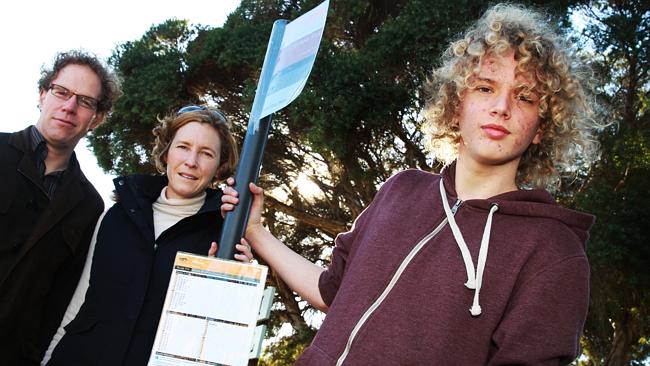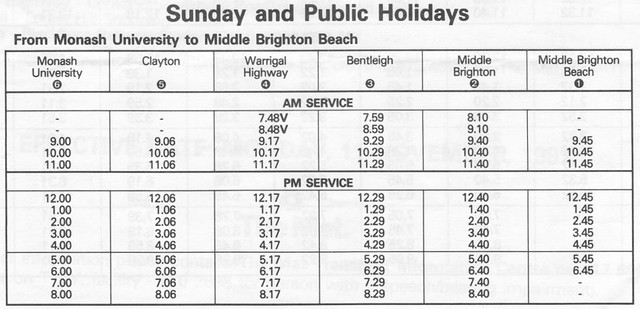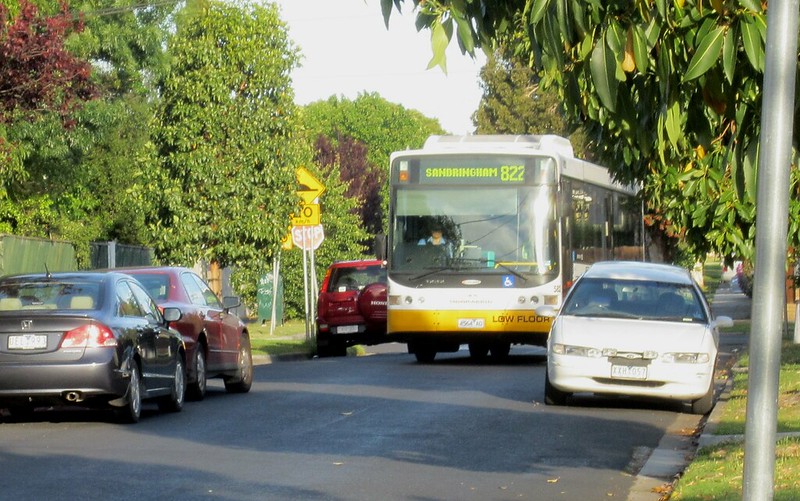The Public Transport Not Traffic campaign organised a story in this week’s local paper, via campaigners Tony, Danita and Oscar setting up a fake bus stop to call for better bus services.
Among the quotes in the story from locals is this one from me:
“Bentleigh has less frequent buses than it did 25 years ago.”
I’ve been (quite reasonably) asked if this is actually true.
Yep, it is (though not universally). Let me present some examples — some within the Bentleigh electorate, some just beyond.
The quote deliberately says 25 years, not 20. This is because in late-1991 (towards the end of the Kirner state government, before Kennett arrived on the scene in October 1992) there were sweeping bus service cuts to middle and outer-suburban routes right across Melbourne. Some routes were changed, combined, and renumbered, but the overall move was towards reduced frequencies.
Just in case you think I’m relying on my shaky memory, I’ve linked to scans of some of the old timetables that I’ve somehow managed to keep in my collection. (It’s not a huge collection. I’m not a timetable collector per se.)
It’s worth remembering that in those days, most shops, including at centres such as Southland, closed at 1pm on Saturdays and weren’t open on Sundays.
Bus 822 — Chadstone to Southland and Sandringham, and in 1992 some trips also extended to North Brighton to through-route to the 823.
- In 1992, this ran every 20 minutes in morning and afternoon peak hours, which helped commuters making train connections at Murrumbeena and Sandringham, particularly in evening peak when it’s harder to accurately guess what time you’ll need the bus. Today this is every 30 minutes in peak hours.
- Going further back to 1987, the route was known as the 655, and extra buses ran between Murrumbeena station and East Bentleigh, meaning a bus about every 15 minutes in peak — double today’s frequency.
Bus 617 — Brighton to Moorabbin and Southland. This has become part of route 811/812 from Brighton all the way to Dandenong (it was also re-routed through the industrial end of Moorabbin, making for a much slower trip from Brighton to Southland):
- Back in 1991, this ran every 20 minutes on weekdays. It’s now every 30.
- In peak it was about every 15 minutes. It’s now every 30.
- On Saturday mornings it was every 30 minutes; in the afternoons about every 50 minutes. It’s now hourly.
(Note also the mention of buses to/from the football at Moorabbin. This sheet also shows the timetable for route 616 from Brighton to South Caulfield, which was scrapped and hasn’t been replaced.)
Bus 618 — from Brighton to Southland, now route 823.
- Back in 1991, this ran every 40 minutes on weekdays. It’s now every 60.
- It also ran about every 45 minutes on Saturday mornings. Now there is no weekend service.
Bus 641 — from Hampton to Highett, with most buses also going to Southland. This route became part of route 828 (Hampton to Berwick):
- The timetable from circa 1990 shows it running about every 12 minutes in afternoon peak between Hampton and Highett stations, with most buses extending to Southland — this is now every 20 minutes.
- For Friday night shopping buses were every 20 minutes to/from Southland. These are now every 30-40 minutes.
- On Saturdays, buses were every 20 minutes in the morning, every 40 in the afternoon. They are now about every 30 minutes in the morning, and every 60 in the afternoon.
Bus 623 — from St Kilda to Chadstone and Glen Waverley:
- Back in 1990, this ran every 30 minutes on Saturday mornings. It’s now hourly.
So as you can see, many buses are less frequent now than they were 25 years ago. In particular, peak hour frequencies dropped markedly — pretty much killing a lot of these routes as effective peak hour feeders to/from the rail system. You can time your walk to the bus stop in the morning, hopefully knowing the train might be frequent enough to avoid a long connection time. But in the evening, with train punctuality not being terribly reliable, it’s risking a long wait if you try and time your connection to a half-hourly bus.
As I said, this is not unique to this area. Cutbacks occurred right across Melbourne, and in most middle and outer suburbs, to this day, bus frequencies are poor.
Not all bad news
It’s not universally true that all buses are less frequent. The Centre Road bus 703 was upgraded from 20 minutes to 15 minutes between the peaks on weekdays as part of the Smartbus program, originated by the Kennett government and largely implemented last decade by Labor.
The 703 also ran only every 40 minutes on Saturdays; it’s now every 30 minutes. It was only hourly on Sundays, compared to about every 45 minutes now. (Hourly is of course easier to memorise). But locals may be intrigued to know that back in 1991, Sunday services did run between Brighton and Bentleigh (but not north of Monash), with some buses extending to Brighton Beach — nowadays there are no buses between Brighton and Bentleigh on Sundays.
Mostly better operating hours: Sundays and evenings
Also: On most routes, operating hours are now longer than they were in the 90s, thanks to funding from the 2006 MOTC (“Meeting Our Transport Challenges”) transport plan under Labor. This introduced (or re-introduced) Sunday services on a lot of bus routes, as well extending hours in many cases to 9pm (though mostly with only hourly services).
These extended hours apply to most of the routes above — the 703 being the exception; despite being tagged as a Smartbus, this route fails to meet the government’s Smartbus standard.
MOTC also resulted in some additional Smartbus upgrades, including the Doncaster area “DART” routes.
Changing times
The 80s and 90s were a time of cost-cutting and mostly declining patronage in public transport. Of course cost cutting and declining patronage feed on each other.
It’s only in the last ten years or so that patronage began to climb again, helped along by factors such as in-fill development (and population growth) in established suburbs.
In this time, a lot of attention has been paid to trains, with those running through some parts of middle and outer Melbourne now every 10 minutes, seven days-a-week. This huge (but largely unadvertised) boost could scarcely have been dreamt about 25 years ago, when Sunday trains were only every 40 minutes, and generally with short trains. Since then, improvements have been delivered by both sides of politics.
But most people are beyond walking distance to trains (and the other frequent mode, trams), and many major destinations (such as Monash Clayton, Chadstone, and including, for now, Southland) are also. Apart from the few Smartbus routes, they remain mostly unusably infrequent.
Better buses — more direct, and more frequent — are vital for helping people make those trips via public transport, as well as providing connections to the train network without people having to drive to over-crowded station car parks.



13 replies on “Melbourne buses: many less frequent than 25 years ago”
Thanks Daniel. The Kirner bus cuts are something of an open secret still – if they’re remembered at all they’re generally attributed to Kennett, but in reality Jeff merely finished the job already done by the previous government. It wasn’t political action as such that wrecked so many bus services – just a weak and embittered planning culture in the old PTC that presented an easy target for the razor gangs. Unfortunately, signs of the same culture are still evident in regional Victoria.
The irony of course is that bus patronage in Melbourne was growing strongly during the 1980s – indeed more strongly than train or tram patronage. By 1989 it was around 30% up on its historical low point in 1981. Multimodal ticketing had a lot to do with this, and people were encouraged to use buses as a feeder mode to railway stations. The early 1990s cuts undid virtually all the good work done over the previous decade – it was only population growth that prevented bus patronage going back to its 1981 level.
Other factors that contributed to increasing PT patronage were:
1. Increases in the cost of petrol. I remember it costing 59.9c/L in the mid 90s.
2. Huge hikes in the cost of CBD parking.
These two things made it uneconomic for most to drive into the city (and a good thing that is too).
Daniel, if you wish to see more timetables from around that time, visit https://sites.google.com/site/krustyklo/
It doesn’t have every route, but it does have a lot of 600 series routes.
I wonder if anyone’s assembled all the old bus routes into a Google Earth KMZ file or something similar?
@Flanders St, wow, that’s an incredible resource!
@David, there have been some route changes, but I think the route structure isn’t as significant historically as the timetables/service frequencies.
If you want a map of the old bus routes, get a copy of a 1991/1992 Melway. It is the first Melway with bus routes.
@Tom, Melways before 1991/1992 did have bus routes in them, though there was a gap for a few years
The 1980-1986 Melways did indeed have bus routes. I wonder why they were removed? Was it the Public Transport Authorities or the company that does Melway?
@Tom, I believe it was due to reviews if bus routes at time
So the info had a chance of being incorrect
Amongst the ubiquitous trend in the late 1980s to 1991 to cutting Melbourne’s bus services, there was one district that enjoyed the exact opposite – a massive “several hundred percent” increase in bus services. That district was exclusive southern Brighton towards the beach, which saw its Monday-to-Friday-only half-hourly service route 644 complemented (then replaced in 1991) with full timetable extensions of the then Metbus route 600 (18 hours/day, 7 days/week), then the new Metbus routes 216 and 219 (on 18/7 span timetables, as extended from the city in 1993 to replace the old city-to-Brighton 602).
In contrast, in the same period, the region of East Brighton southwards of Centre Road LOST nearly one half of the scheduled bus services it enjoyed prior to 1989. Routes 617, 616 and 618 disappeared and were replaced by less frequent routes 811/812 and 823.
These massive increases in service levels in beachside Brighton, and the massive increase in public expenditure to run them, have not been matched by major (or any significant?) increases in bus patronage. This probably reflects the Brighton residents’ wealth and fashion-driven choices of personal transport. Indeed, rates of public transport patronage generated from southern Brighton beach district are significantly below the metropolitan average. For examples, rail patronage boarding via Brighton Beach station is the lowest on the Sandringham line, and walk-up train patronage levels via this station are way below those of any other Sandringham line station (source: PTV patronage data, 2012). Boarding rates and on-board passenger numbers on the sections of bus routes 600, 922 and 923 through this region appear to be well below the metropolitan average. It would be very interesting to know what – if any – properly designed market research and testing and “social disadvantage” analyses were performed to justify those Brighton bus routes upgrades of a quarter century ago.
[…] major destinations such as Chadstone as the famous shopping mall of Melbourne, which is sometimes inactive and lazy, especially on Sundays, the most popular shopping […]
@Peter Hill
Not sure what market research was taken when making these upgrades in Brighton, but they were never well used, and really 216/219/220 should be cut back to Elsternwick.
There too many N-S links in the area, that are just not well used.
For those who use PT, most get the train instead of bother with these N-S routes.
[…] There is huge scope to improve local feeder buses. This goes doubly for the railway stations having their car parks lost – rather than spending up big extending car parks elsewhere, they might have done well to fund additional feeder bus services, particularly in peak hour. (The Murrumbeena bus used to run twice as often in peak hour.) […]